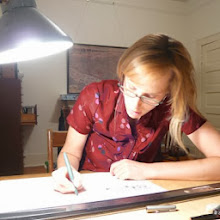





 100 BLOCK Prince Street Alexandria VA; Rough Draft
100 BLOCK Prince Street Alexandria VA; Rough DraftAfter photographing each building, measuring widths (with my own feet, in heels, admittedly), I drew "Captain's Row", the 100 Block of Prince Street in Alexandria. I was happy to draw with my Parker 51, recently resurrected after getting clogged with ink; I thoroughly washed and soaked and dried it back to action.
The block was selected after much deliberation and walking around town. The slope is interesting and a challenge. I like the way the rowhomes shift with the slope; Sill and rooflines do not align between neighbors. Because of the slope, however, the drawing does not appear to be at rest. A solution - and final drawing - is forthcoming...
































